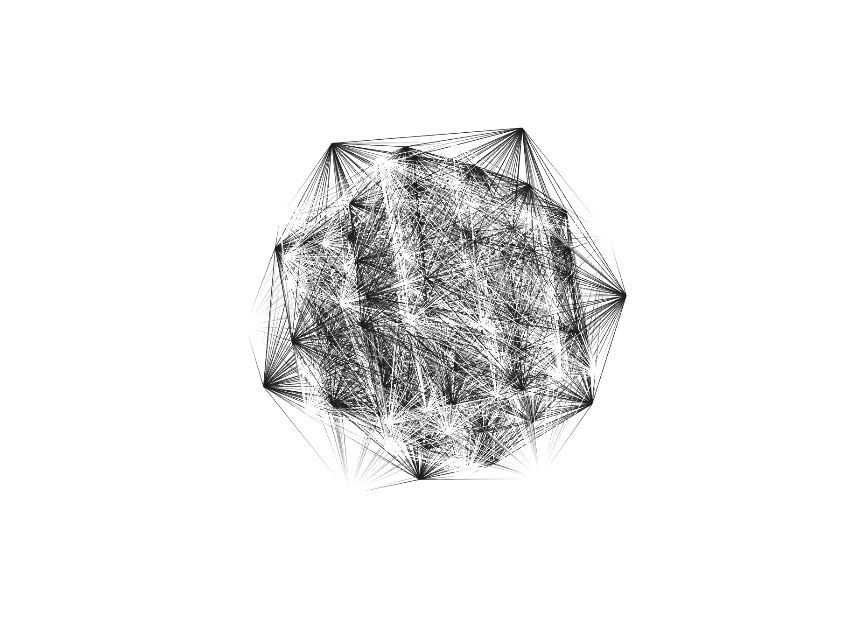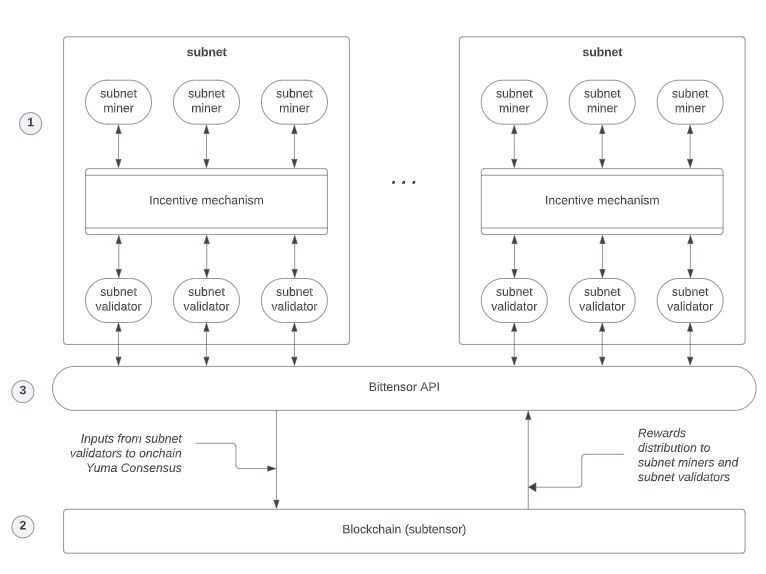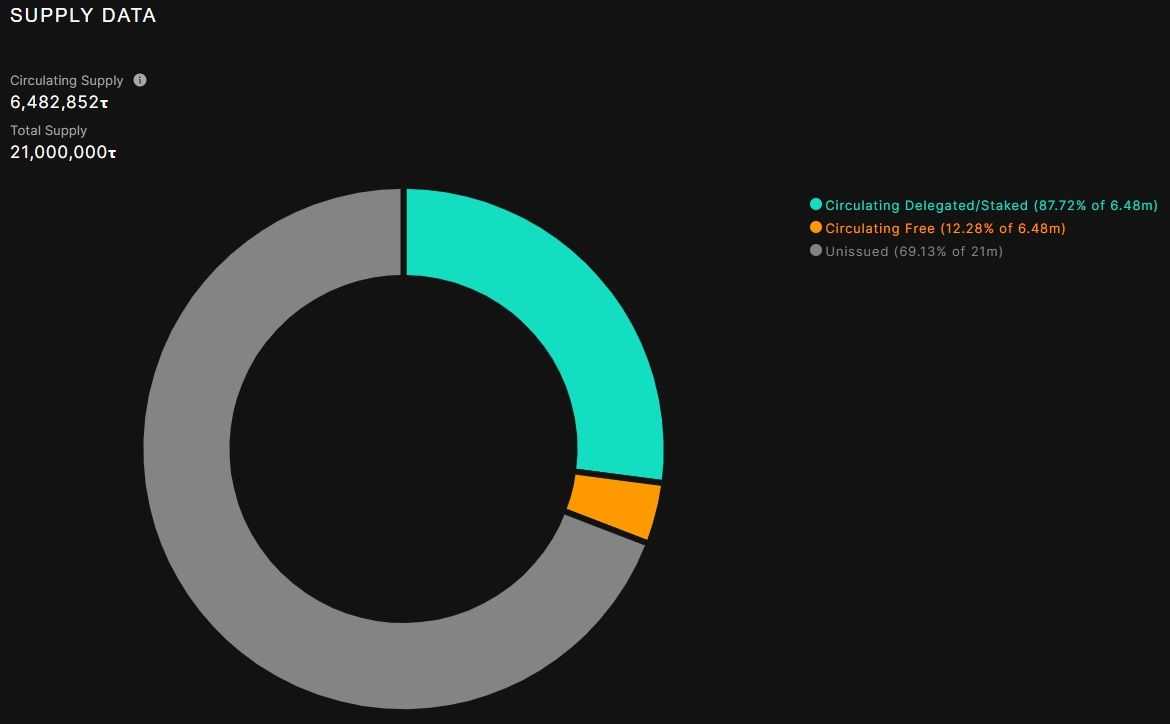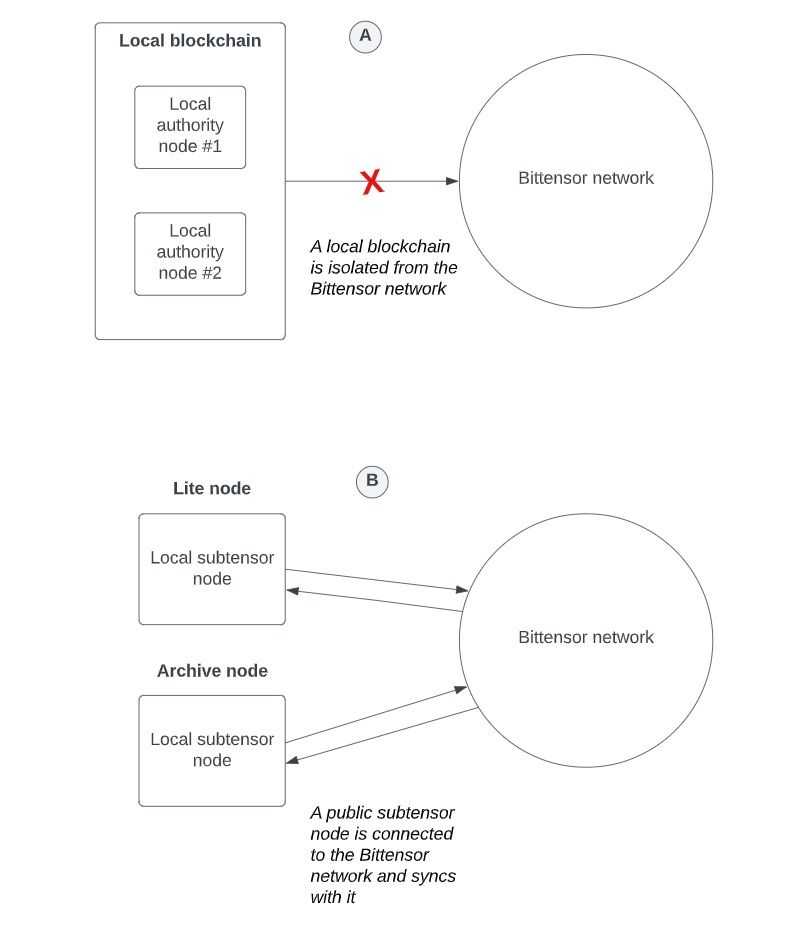Bittensor Review 2024: Decentralized Machine Intelligence
Bittensor is an open-source protocol that facilitates decentralized and collaborative machine learning and AI networks. It operates as a marketplace where machine intelligence models are evaluated based on their comprehensive intelligence, rather than predefined tasks and benchmarks. This approach encourages diversity and innovation in AI development.
The decentralized nature of Bittensor ensures fairness and trustworthiness, as decisions are made collectively without the influence of a single authority. Researchers are directly compensated for their contributions, and consumers can easily access the most intelligent machines for their specific needs.
Bittensor operates through 32 subnets, each with its own purpose and focus. Participants in the network can create their own subnets or join existing ones as subnet miners or subnet validators. Subnet miners receive tasks from validators, compete to complete them, and are rewarded accordingly. Validators assess the quality of the miners' work and ensure that rewards are given only for meaningful insights.
The Bittensor network utilizes the TAO token as its native cryptocurrency. TAO tokens are used to reward subnet miners and validators. The total supply of TAO tokens is 21 million, with halving events occurring approximately every four years. This incentivizes miners and validators to continuously improve the quality and diversity of their outputs.
The benefits of a decentralized approach to AI are numerous, including heightened privacy and security, increased resilience to failures, inclusivity and accessibility, transparency and accountability, and empowerment of individuals. Decentralized AI networks also offer scalability and efficiency, as well as mitigating bias and discrimination.
Overall, Bittensor has the potential to revolutionize machine learning training and AI development by promoting collaboration, inclusivity, and transparency. Its decentralized marketplace for machine intelligence allows for diverse AI models to interact and learn from each other, driving the collective intelligence of the network.
Bittensor is an open-source protocol that facilitates decentralized and collaborative machine learning and AI networks. It operates as a marketplace where machine intelligence models are evaluated based on their comprehensive intelligence, rather than predefined tasks and benchmarks. This approach encourages diversity and innovation in AI development.
The decentralized nature of Bittensor ensures fairness and trustworthiness, as decisions are made collectively without the influence of a single authority. Researchers are directly compensated for their contributions, and consumers can easily access the most intelligent machines for their specific needs.
Bittensor operates through 32 subnets, each with its own purpose and focus. Participants in the network can create their own subnets or join existing ones as subnet miners or subnet validators. Subnet miners receive tasks from validators, compete to complete them, and are rewarded accordingly. Validators assess the quality of the miners' work and ensure that rewards are given only for meaningful insights.
The Bittensor network utilizes the TAO token as its native cryptocurrency. TAO tokens are used to reward subnet miners and validators. The total supply of TAO tokens is 21 million, with halving events occurring approximately every four years. This incentivizes miners and validators to continuously improve the quality and diversity of their outputs.
The benefits of a decentralized approach to AI are numerous, including heightened privacy and security, increased resilience to failures, inclusivity and accessibility, transparency and accountability, and empowerment of individuals. Decentralized AI networks also offer scalability and efficiency, as well as mitigating bias and discrimination.
Overall, Bittensor has the potential to revolutionize machine learning training and AI development by promoting collaboration, inclusivity, and transparency. Its decentralized marketplace for machine intelligence allows for diverse AI models to interact and learn from each other, driving the collective intelligence of the network.
One of the foremost advantages of decentralized artificial intelligence lies in data privacy and security, as decentralized AI enables the training of models across distributed networks without compromising individual users' data privacy. Moreover, decentralized AI systems exhibit greater resilience and robustness, mitigating the risks associated with single points of failure or manipulation.
This approach also fosters inclusivity by widening access to AI technologies, thus promoting innovation across diverse user bases. Crucially, the incorporation of blockchain technology in many decentralized AI projects enhances transparency and accountability, bolstering trust in AI algorithms' decision-making processes.
Projects such as SingularityNET, Injective Protocol, Alethea, and Fetch.AI are pioneering this intersection of AI and blockchain, each contributing unique solutions.
Bittensor is another AI-crypto project that aims to revolutionize machine learning with decentralization.
In this Bittensor review, we delve into the intricacies of Bittensor, exploring its functionalities, consensus and how it's solving current shortcomings in machine learning training.
Bittensor Review Summary:
Bittensor is an open-source protocol that facilitates a decentralized and collaborative machine learning (or AI) network. Not only does Bittensor enable decentralized AI, but it also establishes a marketplace where artificial or machine intelligence transforms into a tradable commodity.
The Limitations of Machine Learning Training
Our current approach to creating intelligent machines is comparable to training racehorses for specific competitions (benchmarks). We focus on optimizing their performance for these predefined tasks and measure success solely within those parameters. This method has its limitations, however. It doesn't inherently reward intelligence or utility beyond these narrow confines, often favouring larger, more generalized solutions while neglecting the potential of smaller, specialized ones.
Now, envision a different strategy. Instead of fixating on specific tasks, we prioritize assessing the overall intelligence and usefulness of these machines. We shift our focus from specialized capabilities to a holistic understanding of intelligence. This way, even machines with unique, specialized skills can receive recognition for their contributions.
That's the crux of Bittensor's offering.
To facilitate this shift, it establishes a marketplace where machine intelligence models are evaluated based on their comprehensive intelligence. This marketplace operates on a digital ledger, functioning as a transparent platform where the smartest machines are identified and rewarded accordingly. By embracing this approach, the project fosters diversity and innovation, valuing intelligence in all its forms rather than solely focusing on predefined benchmarks.
What sets this marketplace apart is its decentralized nature. Unlike traditional systems with centralized control, this marketplace operates as a distributed network of computers. This decentralized structure ensures fairness and trustworthiness, as decisions are made collectively without the influence of a single authority. As a result, researchers are directly compensated for their contributions, and consumers can easily access and procure the most intelligent machines for their specific needs.
What is Bittensor?
Bittensor operates as a digital marketplace where machine learning models converge to share their knowledge and skills. Unlike traditional methods of evaluating machine intelligence, which rely on fixed tests that can be compared to standardized exams in schools, Bittensor introduces a dynamic approach.

Rather than merely excelling at predetermined tasks, machines within Bittensor engage in dialogue over the internet, exchanging insights and learning from one another. Think of it like students discussing concepts in a classroom, fostering a deeper understanding and encouraging creativity beyond rote memorization.
Within the Bittensor ecosystem, recognition and rewards are distributed based on the usefulness of contributions. This feedback is recorded on a digital ledger, acting as a scoreboard that tallies the value each machine brings to the network. These rewards manifest as TAO tokens, Bittonsor's native cryptocurrency. This incentive structure encourages machines to actively participate in knowledge sharing and collaboration, driving the collective intelligence of the network.
To maintain integrity and fairness, Bittensor employs measures to prevent cheating and collusion among machines. Much like proctors overseeing an exam, Bittensor ensures that rewards are only bestowed upon contributions that genuinely enhance the network's value. This safeguards against instances where machines attempt to artificially inflate each other's scores without providing meaningful insights.
By incentivizing diverse contributions and rewarding creativity, Bittensor enables participation from a broad spectrum of stakeholders, transcending the confines of large corporations and empowering individuals to contribute meaningfully to the advancement of AI.
Bittensor Decentralized AI Networks
Think of Bittensor as a central hub, sort of like a big city with multiple neighbourhoods. Each neighbourhood represents a subnet, and they all connect back to the central hub.
Now, just like in a city where neighbourhoods can have different focuses or specialities — like one might be known for its art scene while another for its tech startups — Bittensor's subnets (there are 32 of them) can have different purposes. Some might focus on AI-related projects, while others might be for something entirely different, like gaming or finance.
How Bittensor Decentralizes AI Computation
A subnet in Bittensor is like a competitive marketplace where participants can either create their own subnet or join an existing one. To create a subnet, you simply pay a registration fee in TAO tokens and receive a unique identifier for your subnet. If you want to join an existing subnet, you can do so as either a subnet miner or a subnet validator.

As a subnet miner, you'll receive tasks from subnet validators and compete with other miners to complete them. Once you've completed the task, you submit your results to the subnet validator. The validator then assesses the quality of your work and rewards you accordingly with TAO tokens. This incentivizes miners to produce high-quality work and continuously improve the overall quality of the subnet.
The specific tasks given to subnet miners vary depending on the subnet. For example, one subnet might require miners to respond to text prompts, while another might involve machine translation or providing storage space.
The blockchain, called subtensor, plays a crucial role in recording all the activity within each subnet and determining rewards for subnet miners and validators. An algorithm called Yuma Consensus (YC) runs on the blockchain, computing rewards for miners and validators based on their performance every 12 seconds. These rewards are then deposited into their wallets in the form of TAO tokens.
While there are 32 different subnets in Bittensor, they typically operate independently of each other. However, a new feature called SubnetsAPI allows for cross-subnet communication if needed, enabling greater flexibility and collaboration between subnets.
Bittensor Consensus Mechanism
The Bittensor API empowers subnet owners to create their own incentive mechanisms, allowing subnet validators to express their preferences about what the network should prioritize learning. This approach serves two main purposes:
- Driving Knowledge Improvement: It fosters an economic market where subnet miners, who produce knowledge, are motivated to continuously enhance the speed, intelligence, and diversity of their outputs. This competition ensures that the network constantly evolves and improves.
- Decentralizing Governance: By distributing decision-making power across multiple stakeholders, Bittensor avoids centralization and ensures that no single group controls what the network learns. This decentralization enhances transparency and prevents any one entity from having undue influence.
Subnet validators express their views through a set of weights, which are then aggregated across all validators to create a weight matrix (W). Validators refine their weights by continuously assessing the performance of subnet miners in terms of speed, intelligence, and diversity.
Bittensor's Yuma Consensus algorithm translates the weight matrix into incentives for subnet miners and dividends for subnet validators. However, to prevent manipulation by bad actors, Bittensor employs the Yuma Consensus mechanism. This mechanism rewards validators who produce evaluations aligned with those of other validators, weighted by their stake in the network.
The process ensures that validators are incentivized to provide honest evaluations and maintain consensus, safeguarding the integrity of the network.
Benefits of a Decentralized Approach to AI
Embracing decentralization in AI offers a wide array of benefits. Let's explore!
- Heightened Privacy and Security: In a world dominated by centralized systems, blockchain-crypto projects allow data to be spread out across numerous nodes rather than being stored in a single location. This minimizes the risk of large-scale data breaches, as there's no central point of vulnerability. By keeping data closer to its source and under individual control, decentralized AI enhances privacy and fortifies security.
- Increased Resilience to Failures: In a decentralized AI network, no single node holds all the power. Instead, tasks are distributed across multiple nodes, reducing the impact of any single node failing or being compromised. This resilience to failures or attacks makes decentralized AI systems more robust and reliable.
- Inclusivity and Accessibility: Decentralized AI democratizes access to AI technologies, opening doors for a diverse range of participants to contribute and benefit. Unlike centralized systems that may require significant resources or expertise to engage with, decentralized networks welcome participation from individuals and organizations of all backgrounds.
- Transparent and Accountable: By leveraging blockchain technology, decentralized AI systems establish transparent and immutable records of transactions and decision-making processes. This transparency enhances accountability by allowing stakeholders to trace the lineage of data and algorithms, verify the integrity of AI outcomes, and hold responsible parties accountable for their actions.
- Empowerment of Individuals: Decentralized AI shifts power away from centralized authorities and redistributes it among individual participants. Through decentralized governance mechanisms and peer-to-peer collaboration, individuals have a say in shaping the direction of AI development and deployment.
- Scalability and Efficiency: Decentralized AI networks can harness distributed computing resources, enabling seamless scalability and efficient utilization of computational power. This flexibility allows for the integration of new participants and resources as needed.
- Mitigation of Bias and Discrimination: By dispersing decision-making authority across a diverse network of nodes, decentralized AI systems can help mitigate the risk of bias and discrimination inherent in centralized models. Collaborative governance structures and diverse perspectives contribute to more equitable and inclusive AI outcomes.
TAO Token
TAO is the native cryptocurrency of the Bittensor network and is used to reward subnet miners and validators. According to CoinGecko, TAO is currently the second-largest AI token behind only Render Network.
TAO Tokenomics
The network, initially known as Kusangi, commenced on Jan. 3, 2021, but was temporarily paused in mid-May to address certain issues. Subsequently, the blockchain and all 546,113 previously mined TAO were transferred to Nakamoto, which was established on Nov. 2, 2021, starting from block 0. The Finney network was officially launched on March 20, 2023.

The total supply of 21 million TAO tokens is hardcoded into the system. A new block is mined approximately every 12 seconds, rewarding miners and validators with 1 TAO per block. According to the current inflation schedule, this results in 7,200 new TAO being introduced into circulation every 24 hours, evenly split between miners and validators.
The precise occurrence of the halving event is determined by the total token issuance, rather than the block number. As Tao tokens used for recycling registrations are burned back into the unissued supply, the halving data extends accordingly. However, this data is dynamically calculated based on the current block issuance and automatically updates over time.

Once half of the total supply has been issued, the issuance rate is halved. With a block mined every 12 seconds, this equates to a halving event occurring approximately every four years. Each subsequent halving event occurs at intervals corresponding to half of the remaining TAO to be issued until the full supply of 21 million TAO is in circulation.
Where to buy TAO?
If you're looking to buy TAO, you can do so through MEXC, Bitget, Gate.io and Kucoin. Also, check out our ranking of the best crypto exchanges.
TAO can also be bought through the decentralized exchange Kujira Fin. If you're looking for the best decentralized exchanges, we've got you covered.
Getting Started with Bittensor
Before you can start developing, you must install Bittensor and then create a Bittensor wallet.
The wallet comprises two components: a coldkey and a hotkey, each serving different functions and levels of security. These keys are interconnected through the Bittensor API, facilitating seamless interaction within the network.
The coldkey, encrypted and stored on your device, acts as the safeguard for your funds and facilitates high-risk operations like transfers and staking. Its encryption ensures the secure storage of assets and sensitive transactions, protecting against unauthorized access.
On the other hand, the hotkey, typically unencrypted by default but can be encrypted if desired, is utilized for less secure operations within the network. This includes signing messages, running subnet miners, and validating network activities. Generated from the coldkey, the hotkey provides access to network functionalities while maintaining a lower level of security compared to the coldkey.
Running a Bittensor Node
To run a public subtensor node and sync with the Bittensor network, you have two options: you can either compile the subtensor source code into a binary and run it, or you can use a Docker container.

There are two types of public subtensor nodes:
- Lite nodes synchronize with only a few latest blocks of the Bittensor blockchain, minimizing storage requirements. They serve as entry points into the Bittensor mainchain or testchain. Subnet miners typically use lite nodes to communicate with the Bittensor blockchain.
- Archive nodes store all Bittensor blockchain blocks from genesis up to the most recent block. They are used for applications such as Bittensor blockchain explorers, which require access to historical blockchain data.
It's important to note that running a public subtensor node locally is not the same as running a local blockchain for development and testing purposes. A local blockchain is isolated from the Bittensor network and is used specifically for subnet incentive mechanism development and testing.
To run a public subtensor node, your computer needs to meet certain system requirements:
- For Linux: Only x86_64 architecture is supported, and you'll need approximately 286 MiB of space.
- For macOS: Only x86_64 architecture is supported, and you'll need macOS 10.7 or later.
Additionally, your subtensor node must have access to the public internet and run in an IPv4 network. Make sure to open network ports on your subtensor node to allow other peer subtensor nodes to connect to it.
Bittensor vs Bitcoin
Bittensor and Bitcoin share some fundamental similarities, but they also have significant differences in their objectives and operations.
- Purpose: Bitcoin's primary purpose is to create a decentralized digital currency system that is secure, censorship-resistant, and immutable. It achieves this by using a proof-of-work consensus mechanism to validate transactions and secure the network. Bittensor, on the other hand, aims to create a decentralized marketplace for intelligence and computational resources. While it also utilizes proof-of-work, its focus is on building value-creating markets and incentivizing the development of AI models and other applications.
- Market Focus: Bitcoin's market focus is primarily on securing its network and ensuring the immutability of its token economic system. It achieves this by incentivizing miners to compete for block rewards and transaction fees. In contrast, Bittensor's market focus is on building markets for intelligence and computational resources. It incentivizes miners to contribute computing power to train AI models and perform other tasks that add value to the network.
- Product: Bitcoin's product is essentially its blockchain and the digital currency it supports. While the blockchain itself has immense value in terms of decentralization and security, Bitcoin's utility is primarily limited to being a digital currency. Bittensor, on the other hand, offers a broader range of products and services, including decentralized AI model training, data storage and sharing, decentralized oracles, distributed computing for research, and more. These products leverage the network's computational resources to create real-world value beyond just a digital currency.
- Network Growth: Both Bitcoin and Bittensor incentivize network growth through mining rewards, but they do so for different purposes. Bitcoin's network growth is focused on increasing its computational power to maintain security and decentralization. Bittensor's network growth, on the other hand, is focused on expanding its computational resources to support the development of AI models and other applications that require significant computing power.
Bittensor Review: Closing Thoughts
By leveraging decentralized networks and incentivizing collaboration among participants, Bittensor aims to revolutionize the way we approach machine learning training and AI development.
One of the key strengths of Bittensor lies in its decentralized nature, which addresses fundamental issues found in centralized AI systems. Decentralization not only enhances data privacy and security but also fosters inclusivity and innovation by widening access to AI technologies. Through its dynamic marketplace for machine intelligence, Bittensor provides a platform where diverse AI models can interact, learn from each other, and contribute meaningfully to the network's collective intelligence.
Overall, Bittensor holds immense promise in reshaping the future of AI by promoting collaboration, inclusivity, and transparency in machine learning training and AI development.
Frequently Asked Questions
Bittensor is an open-source protocol that facilitates decentralized and collaborative machine learning networks. It establishes a marketplace where machine intelligence models can interact, learn, and contribute to the network's collective intelligence.
Bittensor operates as a decentralized network where AI models converge to share knowledge and skills. Through its dynamic marketplace, machines engage in dialogue, exchange insights, and receive rewards based on the usefulness of their contributions.
TAO tokens are the native cryptocurrency of the Bittensor network. They are used to reward subnet miners and validators for their contributions to the network's intelligence. TAO tokens are distributed based on the value of contributions recorded on the network's digital ledger.
Bittensor enables decentralized AI, establishes a marketplace for machine intelligence, rewards creativity and diversity in contributions, fosters collaboration among participants, and ensures transparency and accountability through blockchain technology.
While both Bittensor and Bitcoin utilize decentralized networks and proof-of-work consensus mechanisms, Bittensor focuses on building value-creating markets for intelligence and computational resources, whereas Bitcoin primarily serves as a decentralized digital currency system.
TAO tokens can be purchased through various cryptocurrency exchanges such as MEXC, Bitget, Gate.io, and Kucoin. Additionally, decentralized exchanges like Kujira Fin also offer TAO tokens for trading.
Disclaimer: These are the writer’s opinions and should not be considered investment advice. Readers should do their own research.

